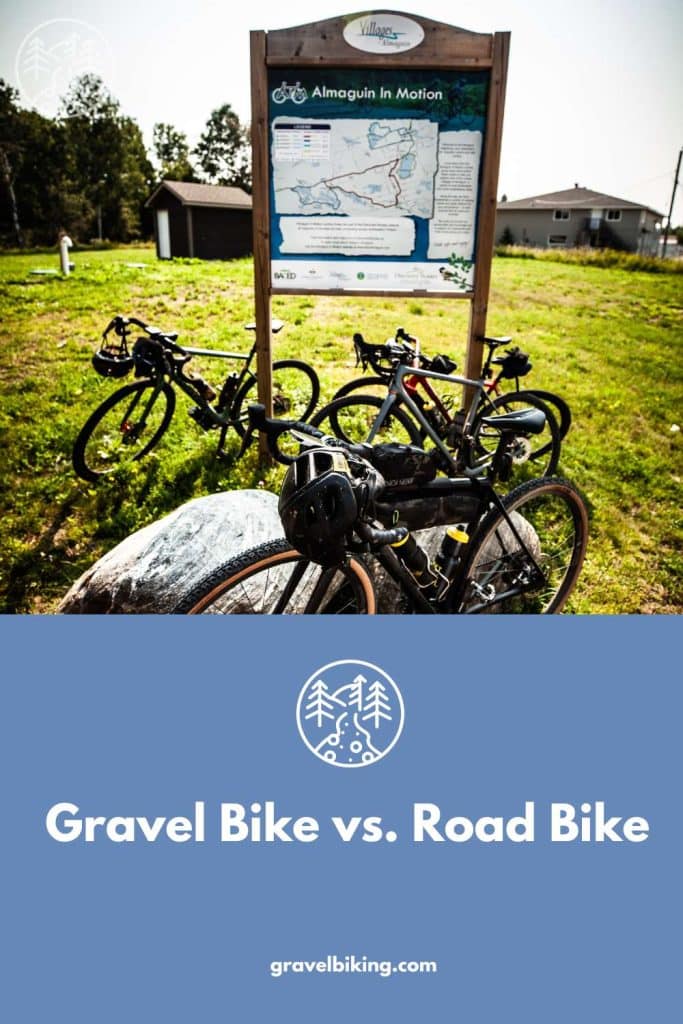The recent boom in gravel biking’s popularity has stirred up debate about the crucial differences between gravel models and traditional road bikes. While they may look similar at a glance, certain features are better suited to specific terrains and rider preferences. Keep reading to learn more about gravel bike vs road bike and settle the discussion once and for all.

What is a Gravel Bike vs Road Bike?
Gravel bikes are a beefier version of road bikes, complete with wider tires and more relaxed geometry. Gravel machines feel bumpy on surfaces like cobblestones and light trails whereas road bikes perform best on smooth pavement.
What is a gravel bike?
Gravel bikes are built for multi-surface riding and traversing across gravel paths, sandy trails, and smooth roads. From a distance, gravel bikes can appear like standard road bikes due to the shared drop bars and rigid frames. But they have much wider tires. Some models also come with MTB-inspired 1x gearing. Plus, additional off-road features that enhance their ability to explore the path less traveled.
Gravel bikes are one of the latest evolutions of traditional road and hybrid bikes and are the go-to choice in places where routes include cobblestones, light gravel, and smooth pavement in quick succession. Other riders love gravel bikes simply because of their all-rounder performance. Riding a versatile gravel bike lets cyclists navigate the changing terrain as well as handle mud or inclement weather— after all, this discipline was born out of the rainy countryside of Belgium.

What is a road bike?
Road bikes are streamlined and lightweight two-wheelers designed for speed on smooth pavement. Road bikes leverage their low weight and aerodynamic gains to help cyclists pedal as efficiently as possible during races or weekend outings. Think of the Tour de France and you’ll remember the skinny tires, aggressive geometry, and high-end components that are typical on modern road bikes.
Road bikes feel most at home on smooth asphalt and will quickly reach their limits on technical trails compared to gravel bikes. These machines are perfect for cyclists who stick to the roads and are looking to slice through the air and ride with maximum pace.
Gravel Bike vs Road Bike: Key Features and Differences
Gravel bikes have taken the cycling industry by storm with their added features so more riders than ever are having to make the choice between going gravel or sticking with road models. With so many amazing gravel and road bikes on the market, making the right decision depends on the type of riding you expect to do as well as your own preferences. Check out the main differences between the two popular categories below:
Tires
Gravel bikes typically rock rubber that’s around 40mm wide in order to have a smoother ride over bumpy terrain and achieve a better grip. There are tons of creative tread patterns and specific widths that gravel enthusiasts can play around with, but they are normally above 35mm and feature small knobs for extra traction— this combo hits the sweet spot between road efficiency and trail performance. Wider rims or wheels are compatible with these beefier tire sizes and it isn’t uncommon these days to see gravel tires reaching up to 45mm.
Traditional road bike philosophy preached that skinny tires are always better but modern studies are pushing us in the opposite direction. Old-school racing often featured thin rubber between 19-23mm whereas updated science shows that slightly wider tires help reduce rolling resistance. The most common tire design these days is between 25-28mm with a slick tread pattern.
Frame
Cyclists also often compare gravel vs road bike geometry. Gravel frames borrow heavily from road bike design while altering the geometry for a more relaxed riding position. All that bumping and bobbling over gravel paths can take a toll on the body and a more relaxed posture keeps the rider in control and less fatigued throughout the session. One crucial change is the taller head tube on gravel bikes which improves steering and handling in off-road sections. And when it comes to endurance road bikes vs gravel bikes, they share a relaxed frame shape but endurance models stick to the skinny and slick tires of road bikes.
Additional gravel adjustments include a higher bottom bracket that’s out of the way of any trail debris as well as a longer wheelbase to boost stability over rough patches. Many gravel bikes come with integrated frame mounts so riders can install extra water bottle cages and frame bags that are useful for backpacking or adventure riding. This approach differs from road bikes where low weight and aerodynamics are the main priorities.
Gears
Drivetrains and gears on gravel bikes have been heavily influenced by the off-road technology on mountain bikes such as 1x systems, clutched rear derailleurs, and wide-range cassettes. Products like the Shimano GRX groupset are gravel-specific components that are available as either 1x or 2x setups and reduce chain slap over rough terrain thanks to a clutch on the rear mech. 1x gravel groupsets typically come with an 11-40t or 11-42t cassette that’s hooked up to a 40 or 42t front narrow-wide chainring.
Almost all modern road bikes come equipped with a 2x groupset. The front double chainring measures around 39- or 42-tooth on the inside and has a much bigger 52- or 53-tooth outer ring. The cassettes have a smaller gear spread because of the additional chainring and typically clock in at around 11-28t.
Brakes
The cycling industry doesn’t often come to a consensus but the near-universal acceptance of disc brakes is shared across gravel and road bikes. Gravel biking has long praised the extra stopping power of disc brakes— especially hydraulic brakes— which perform significantly better than rim brakes in wet and muddy conditions. Road bikes have joined the party more full-heartedly only in the past few years. As of 2021, each of the UCI World Tour teams has phased out rim brakes in favor of higher-performance disc brakes that are now light enough for the gram-saving habits of the pros.
Suspension
Neither gravel bikes nor road bikes are very big fans of suspension but it isn’t unheard of to see a gravel bike with a short-travel front fork. Gravel frames are built to be compliant in all the right directions to absorb some of the vibrations over rough terrain and the wider tires help cushion the ride so suspension isn’t necessary. That said, there are some innovative designs out there that pair a suspension fork with a gravel frame. Road bikes don’t require any suspension since they ride over smooth surfaces and can’t lose efficiency on the climbs due to a plush fork or rear shock.
Handlebars
The beloved drop bar handlebar unites gravel and road bikes, allowing riders to utilize a variety of hand positions to reduce fatigue and enhance control. Road handlebars are about shoulder-width without being too narrow which can make handling feel twitchy at high speeds. There’s a bit more variation in gravel handlebars, including flared-out bar ends that allow for a wider grip for extra leverage in technical sections.
Pedals
While standard flat pedals will technically work with both bike types, manufacturers and cyclists typically outfit these models with clipless pedals. Clipless pedals keep shoes (and hence feet) locked into the ideal position which can reduce knee strain (when fitted properly) and prevent slipping when really putting the power down or riding over bumpy terrain. Road pedals often use the tri-bolt Look or SPD-SL design with a wider platform whereas gravel riders have free reign to choose between road or MTB-style clipless pedals with SPD or eggbeater mechanisms.
Can I use my road bike as a gravel bike?
If your road bike has sufficient tire clearance, you may be able to achieve performance that’s close to a dedicated gravel bike. Wider tires are key for gravel riding and are typically larger than 700x35c. It’s totally common, though, to explore light gravel routes on tires 28mm and up.
Is a gravel bike more comfortable than a road bike?
Yes, gravel bikes feature more relaxed frame geometry as well as wider tires that can soak up the bumps in the road. Taller head tubes let riders pedal in a more upright position that’ll be more comfortable over rough terrain and during long sessions in the saddle.
Is a gravel bike better than a road bike?
Gravel bikes perform much better than road bikes on rougher surfaces such as cobblestones, gravel paths, and dirt tracks. Riders who frequent routes that include a combination of those terrains will enjoy gravel bikes’ versatility but road bikes will always be faster on smooth asphalt.
What is the main difference between a road bike and a gravel bike?
While the biggest difference between gravel and road models is tire width, there are several other component changes across the bike that preps the machine for off-road adventures. Beyond that, the most crucial factor when it comes to the gravel bike vs road bike debate is actually getting out there and riding. Road bikes are plenty capable and roadies should feel confident testing the waters even if they have skinny tires— if they catch the gravel riding bug, they can invest in a gravel-specific setup that’s even better suited for off-road expeditions.
Read More: 7 Best Gravel Bike Shoes

